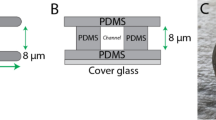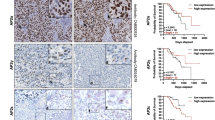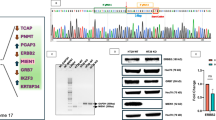Abstract
Malignant melanoma, characterized by invasive local growth and early formation of metastases, is the most aggressive type of skin cancer. Melanoma inhibitory activity (MIA), secreted by malignant melanoma cells, interacts with the cell adhesion receptors, integrins α4β1 and α5β1, facilitating cell detachment and promoting formation of metastases. In the present study, we demonstrate that MIA secretion is confined to the rear end of migrating cells, while in non-migrating cells MIA accumulates in the actin cortex. MIA protein takes a conventional secretory pathway including coat protein complex I (COPI)- and coat protein complex II (COPII)-dependent protein transport to the cell periphery, where its final release depends on intracellular Ca2+ ions. Interestingly, the Ca2+-activated K+-channel, subfamily N, member 4 (KCa3.1), known to be active at the rear end of migrating cells, was found to support MIA secretion. Secretion was diminished by the specific KCa3.1 channel inhibitor TRAM-34 and by expression of dominant-negative mutants of the channel. In summary, we have elucidated the migration-associated transport of MIA protein to the cell rear and also disclosed a new mechanism by which KCa3.1 potassium channels promote cell migration.
Similar content being viewed by others
Log in or create a free account to read this content
Gain free access to this article, as well as selected content from this journal and more on nature.com
or
Abbreviations
- COPI:
-
(coat protein complex I)
- COPII:
-
(coat protein complex II)
- DMEM:
-
(Dulbecco's modified Eagle's medium)
- KCa3.1:
-
(Ca2+-activated K+-channel, subfamily N, member 4)
- MIA:
-
(melanoma inhibitory activity)
- MTOC:
-
(microtubule organizing center)
- SNARE:
-
(soluble N-ethylmaleimide-sensitive factor attachment receptor)
References
Bosserhoff AK, Kaufmann M, Kaluza B, et al. Melanoma-inhibiting activity, a novel serum marker for progression of malignant melanoma. Cancer Res 1997; 57:3149–3153.
Bosserhoff AK, Stoll R, Sleeman JP, et al. Active detachment involves inhibition of cell-matrix contacts of malignant melanoma cells by secretion of melanoma inhibitory activity. Lab Invest 2003; 83:1583–1594.
Poser I, Tatzel J, Kuphal S, Bosserhoff AK . Functional role of MIA in melanocytes and early development of melanoma. Oncogene 2004; 23:6115–6124.
Bosserhoff AK, Lederer M, Kaufmann M, et al. MIA, a novel serum marker for progression of malignant melanoma. Anticancer Res 1999; 19:2691–2693.
Dreau D, Bosserhoff AK, White RL, Buettner R, Holder WD . Melanoma-inhibitory activity protein concentrations in blood of melanoma patients treated with immunotherapy. Oncol Res 1999; 11:55–61.
Stahlecker J, Gauger A, Bosserhoff A, et al. MIA as a reliable tumor marker in the serum of patients with malignant melanoma. Anticancer Res 2000; 20:5041–5044.
Bauer R, Humphries M, Fassler R, et al. Regulation of integrin activity by MIA. J Biol Chem 2006; 281:11669–11677.
Schmidt J, Bosserhoff AK . Processing of MIA protein during melanoma cell migration. Int J Cancer 2009.
Blesch A, Bosserhoff AK, Apfel R, et al. Cloning of a novel malignant melanoma-derived growth-regulatory protein, MIA. Cancer Res 1994; 54:5695–5701.
Rabouille C, Klumperman J . Opinion: the maturing role of COPI vesicles in intra-Golgi transport. Nat Rev Mol Cell Biol 2005; 6:812–817.
Jena BP . Membrane fusion: role of SNAREs and calcium. Protein Pept Lett 2009; 16:712–717.
Komuro H, Kumada T . Ca2+ transients control CNS neuronal migration. Cell Calcium 2005; 37:387–393.
Pettit EJ, Fay FS . Cytosolic free calcium and the cytoskeleton in the control of leukocyte chemotaxis. Physiol Rev 1998; 78:949–967.
Brundage RA, Fogarty KE, Tuft RA, Fay FS . Calcium gradients underlying polarization and chemotaxis of eosinophils. Science 1991; 254:703–706.
Hahn K, DeBiasio R, Taylor DL . Patterns of elevated free calcium and calmodulin activation in living cells. Nature 1992; 359:736–738.
Schwab A, Wojnowski L, Gabriel K, Oberleithner H . Oscillating activity of a Ca(2+)-sensitive K+ channel. A prerequisite for migration of transformed Madin-Darby canine kidney focus cells. J Clin Invest 1994; 93:1631–1636.
Franco SJ, Huttenlocher A . Regulating cell migration: calpains make the cut. J Cell Sci 2005; 118:3829–3838.
Jager H, Dreker T, Buck A, et al. Blockage of intermediate-conductance Ca2+-activated K+ channels inhibit human pancreatic cancer cell growth in vitro. Mol Pharmacol 2004; 65:630–638.
Tajima N, Schonherr K, Niedling S, et al. Ca2+-activated K+ channels in human melanoma cells are up-regulated by hypoxia involving hypoxia-inducible factor-1alpha and the von Hippel-Lindau protein. J Physiol 2006; 571:349–359.
Wang J, Xu YQ, Liang YY, et al. An intermediate-conductance Ca(2+)-activated K(+) channel mediates B lymphoma cell cycle progression induced by serum. Pflugers Arch 2007; 454:945–956.
Lallet-Daher H, Roudbaraki M, Bavencoffe A, et al. Intermediate-conductance Ca2+-activated K+ channels (IKCa1) regulate human prostate cancer cell proliferation through a close control of calcium entry. Oncogene 2009; 28:1792–1806.
Schwab A, Gabriel K, Finsterwalder F, et al. Polarized ion transport during migration of transformed Madin-Darby canine kidney cells. Pflugers Arch 1995; 430:802–807.
Schwab A, Reinhardt J, Schneider SW, Gassner B, Schuricht B . K(+) channel-dependent migration of fibroblasts and human melanoma cells. Cell Physiol Biochem 1999; 9:126–132.
Cruse G, Duffy SM, Brightling CE, Bradding P . Functional KCa3.1 K+ channels are required for human lung mast cell migration. Thorax 2006; 61:880–885.
Kessler W, Budde T, Gekle M, Fabian A, Schwab A . Activation of cell migration with fibroblast growth factor-2 requires calcium-sensitive potassium channels. Pflugers Arch 2008; 456:813–823.
Palazzo AF, Joseph HL, Chen YJ, et al. Cdc42, dynein, and dynactin regulate MTOC reorientation independent of Rho-regulated microtubule stabilization. Curr Biol 2001; 11:1536–1541.
Nebenfuhr A, Ritzenthaler C, Robinson DG . Brefeldin A: deciphering an enigmatic inhibitor of secretion. Plant Physiol 2002; 130:1102–1108.
Iida J, Wilhelmson KL, Price MA, et al. Membrane type-1 matrix metalloproteinase promotes human melanoma invasion and growth. J Invest Dermatol 2004; 122:167–176.
Mori H, Tomari T, Koshikawa N, et al. CD44 directs membrane-type 1 matrix metalloproteinase to lamellipodia by associating with its hemopexin-like domain. EMBO J 2002; 21:3949–3959.
Nugent MA, Iozzo RV . Fibroblast growth factor-2. Int J Biochem Cell Biol 2000; 32:115–120.
Nickel W . Unconventional secretory routes: direct protein export across the plasma membrane of mammalian cells. Traffic 2005; 6:607–614.
Aridor M, Bannykh SI, Rowe T, Balch WE . Sequential coupling between COPII and COPI vesicle coats in endoplasmic reticulum to Golgi transport. J Cell Biol 1995; 131:875–893.
Barlowe C, Orci L, Yeung T, et al. COPII: a membrane coat formed by Sec proteins that drive vesicle budding from the endoplasmic reticulum. Cell 1994; 77:895–907.
Kuge O, Kuge S . [COP-coated vesicles in intracellular protein transport]. Tanpakushitsu Kakusan Koso 1995; 40:2427–2435.
Gaynor EC, Graham TR, Emr SD . COPI in ER/Golgi and intra-Golgi transport: do yeast COPI mutants point the way? Biochim Biophys Acta 1998; 1404:33–51.
Hachiya NS, Watanabe K, Yamada M, Sakasegawa Y, Kaneko K . Anterograde and retrograde intracellular trafficking of fluorescent cellular prion protein. Biochem Biophys Res Commun 2004; 315:802–807.
Schwab A . Function and spatial distribution of ion channels and transporters in cell migration. Am J Physiol Renal Physiol 2001; 280:F739–F747.
Ghanshani S, Wulff H, Miller MJ, et al. Up-regulation of the IKCa1 potassium channel during T-cell activation. Molecular mechanism and functional consequences. J Biol Chem 2000; 275:37137–37149.
Barfod ET, Moore AL, Roe MW, Lidofsky SD . Ca2+-activated IK1 channels associate with lipid rafts upon cell swelling and mediate volume recovery. J Biol Chem 2007; 282:8984–8993.
Strayer DS, Hoek JB, Thomas AP, White MK . Cellular activation by Ca2+ release from stores in the endoplasmic reticulum but not by increased free Ca2+ in the cytosol. Biochem J 1999; 344 Pt 1:39–46.
Kauffman RF, Taylor RW, Pfeiffer DR . Cation transport and specificity of ionomycin. Comparison with ionophore A23187 in rat liver mitochondria. J Biol Chem 1980; 255:2735–2739.
Ridley AJ, Schwartz MA, Burridge K, et al. Cell migration: integrating signals from front to back. Science 2003; 302:1704–1709.
Vicente-Manzanares M, Webb DJ, Horwitz AR . Cell migration at a glance. J Cell Sci 2005; 118:4917–4919.
Borregaard N, Lollike K, Kjeldsen L, et al. Human neutrophil granules and secretory vesicles. Eur J Haematol 1993; 51:187–198.
Jamur MC, Vugman I, Hand AR . Ultrastructural and cytochemical studies of acid phosphatase and trimetaphosphatase in rat peritoneal mast cells developing in vivo. Cell Tissue Res 1986; 244:557–563.
Burkhardt JK, Hester S, Lapham CK, Argon Y . The lytic granules of natural killer cells are dual-function organelles combining secretory and pre-lysosomal compartments. J Cell Biol 1990; 111:2327–2340.
Peters PJ, Borst J, Oorschot V, et al. Cytotoxic T lymphocyte granules are secretory lysosomes, containing both perforin and granzymes. J Exp Med 1991; 173:1099–1109.
Bennett MK . Ca2+ and the regulation of neurotransmitter secretion. Curr Opin Neurobiol 1997; 7:316–322.
Greengard P, Valtorta F, Czernik AJ, Benfenati F . Synaptic vesicle phosphoproteins and regulation of synaptic function. Science 1993; 259:780–785.
Kato M, Sasaki T, Ohya T, et al. Physical and functional interaction of rabphilin-3A with alpha-actinin. J Biol Chem 1996; 271:31775–31778.
Miyazaki M, Shirataki H, Kohno H, et al. Identification as beta-adducin of a protein interacting with rabphilin-3A in the presence of Ca2+ and phosphatidylserine. Biochem Biophys Res Commun 1994; 205:460–466.
Weis S, Schneggenburger R, Neher E . Properties of a model of Ca(++)-dependent vesicle pool dynamics and short term synaptic depression. Biophys J 1999; 77:2418–2429.
Saadoun S, Papadopoulos MC, Hara-Chikuma M, Verkman AS . Impairment of angiogenesis and cell migration by targeted aquaporin-1 gene disruption. Nature 2005; 434:786–792.
Stock C, Schwab A . Role of the Na/H exchanger NHE1 in cell migration. Acta Physiol (Oxf) 2006; 187:149–157.
Lawson MA, Maxfield FR . Ca(2+)- and calcineurin-dependent recycling of an integrin to the front of migrating neutrophils. Nature 1995; 377:75–79.
Yang S, Huang XY . Ca2+ influx through L-type Ca2+ channels controls the trailing tail contraction in growth factor-induced fibroblast cell migration. J Biol Chem 2005; 280:27130–27137.
Meyer R, Schonherr R, Gavrilova-Ruch O, Wohlrab W, Heinemann SH . Identification of ether a go-go and calcium-activated potassium channels in human melanoma cells. J Membr Biol 1999; 171:107–115.
Aiyar J . Potassium channels in leukocytes and toxins that block them: structure, function and therapeutic implications. Pererspect Drug Discov Des 1999; 15/16:257–280.
Eder C . Ion channels in microglia (brain macrophages). Am J Physiol 1998; 275:C327–C342.
Kohler R, Wulff H, Eichler I, et al. Blockade of the intermediate-conductance calcium-activated potassium channel as a new therapeutic strategy for restenosis. Circulation 2003; 108:1119–1125.
Ouadid-Ahidouch H, Roudbaraki M, Delcourt P, et al. Functional and molecular identification of intermediate-conductance Ca(2+)-activated K(+) channels in breast cancer cells: association with cell cycle progression. Am J Physiol Cell Physiol 2004; 287:C125–C134.
Parihar AS, Coghlan MJ, Gopalakrishnan M, Shieh CC . Effects of intermediate-conductance Ca2+-activated K+ channel modulators on human prostate cancer cell proliferation. Eur J Pharmacol 2003; 471:157–164.
Schwab A, Westphale HJ, Wojnowski L, Wunsch S, Oberleithner H . Spontaneously oscillating K+ channel activity in transformed Madin-Darby canine kidney cells. J Clin Invest 1993; 92:218–223.
Jin M, Defoe DM, Wondergem R . Hepatocyte growth factor/scatter factor stimulates Ca2+-activated membrane K+ current and migration of MDCK II cells. J Membr Biol 2003; 191:77–86.
Schilling T, Stock C, Schwab A, Eder C . Functional importance of Ca2+-activated K+ channels for lysophosphatidic acid-induced microglial migration. Eur J Neurosci 2004; 19:1469–1474.
Schwab A, Wulf A, Schulz C, et al. Subcellular distribution of calcium-sensitive potassium channels (IK1) in migrating cells. J Cell Physiol 2006; 206:86–94.
Schwab A, Schuricht B, Seeger P, Reinhardt J, Dartsch PC . Migration of transformed renal epithelial cells is regulated by K+ channel modulation of actin cytoskeleton and cell volume. Pflugers Arch 1999; 438:330–337.
Rao JN, Platoshyn O, Li L, et al. Activation of K(+) channels and increased migration of differentiated intestinal epithelial cells after wounding. Am J Physiol Cell Physiol 2002; 282:C885–C898.
Feinshreiber L, Singer-Lahat D, Ashery U, Lotan I . Voltage-gated potassium channel as a facilitator of exocytosis. Ann N Y Acad Sci 2009; 1152:87–92.
Ho SN, Hunt HD, Horton RM, Pullen JK, Pease LR . Site-directed mutagenesis by overlap extension using the polymerase chain reaction. Gene 1989; 77:51–59.
Tatzel J, Poser I, Schroeder J, Bosserhoff AK . Inhibition of melanoma inhibitory activity (MIA) expression in melanoma cells leads to molecular and phenotypic changes. Pigment Cell Res 2005; 18:92–101.
Neher E . The use of fura-2 for estimating Ca buffers and Ca fluxes. Neuropharmacology 1995; 34:1423–1442.
Acknowledgements
We are indebted to Dr J Johnson (University of Munich, Germany) for providing the melanoma cell lines, Mel Im and Mel Ju, and to Dr B Distel (University of Amsterdam, Netherlands) for providing the Sar1p (H79G) vector. We also thank Dr A Schwab (University of Muenster, Germany) for the generous donation of the expression vector of the KCa3.1 channel and Dr C Voelker (University of Bonn, Germany) for the Golgi-GFP (endomannosidase) plasmid. This work was supported by grants from the DFG and the German Cancer Aid (Melanoma Research Network).
Author information
Authors and Affiliations
Corresponding author
Additional information
(Supplementary information is linked to the online version of the paper on the Cell Research website.)
Supplementary information
Supplementary information, Figure S1
Effect of BFA treatment on the subcellular distribution of MMP14 and bFGF in the human melanoma cell line Mel Im. (PDF 110 kb)
Supplementary information, Figure S2
Effect of KCa3.1 activator 1-EBIO and inhibitor TRAM-34 on MIA protein secretion and migration in the presence of BAPTA AM in the human melanoma cell lines Mel Im and Mel Ju. (PDF 41 kb)
Rights and permissions
About this article
Cite this article
Schmidt, J., Friebel, K., Schönherr, R. et al. Migration-associated secretion of melanoma inhibitory activity at the cell rear is supported by KCa3.1 potassium channels. Cell Res 20, 1224–1238 (2010). https://doi.org/10.1038/cr.2010.121
Received:
Revised:
Accepted:
Published:
Issue date:
DOI: https://doi.org/10.1038/cr.2010.121
Keywords
This article is cited by
-
LC–MS/MS Method for Detection of a Highly Selective KCa3.1 Blocker, TRAM-34, in Rat Plasma
Chromatographia (2014)



